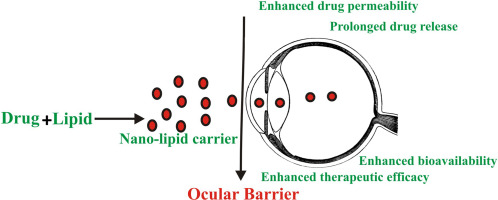Breaking the ocular barrier through nano-lipid carriers to treat intraocular diseases

Abstract
The human eye is a special organ. Its defense mechanisms protect it from invading microbes and harmful molecules. Treatment of different eye diseases often shows poor results due to the presence of these barriers. Nano lipid carriers have the capability to overcome these anatomical and physiological barriers effectively. It can also deliver the payload to the posterior eye. These non-toxic, biocompatible carriers significantly increase the ocular bioavailability of the drug. This review highlights the important ocular barriers and the way how nano lipid carriers overcome the tough ocular barriers.
Introduction
Vision is the most dominant sense of humans. It is important at every step of our life. A newborn baby recognizes his mother depending on vision. He wonders and sees the world through his eyes. Unfortunately, the global scenario of vision impairment is worsening day by day. According to the WHO report 2019, globally minimum of 2.2 billion people have some kind of compromised vision [1]. According to this report, worsening vision impairment can create financial burdens for the countries. The USA costs each year approximately $16.5 billion to tackle this serious issue. The eye is a very unique and complex structure that limits drug targeting. The structurally human eye has two parts; the anterior section and the posterior section. The cornea, conjunctiva, sclera, aqueous humor chamber, iris, pupil, ciliary bodies, and lens are part of the anterior portion. On the other hand, the retina, optic nerve, vitreous chamber, choroid and sclera form the posterior eye section. Most of the medications are prepared as simple eye drop formulations and ointments to fight different eye diseases. More than 90% of the ophthalmic preparations include eye drops.
Despite being inexpensive, patient-friendly, and easy to manufacture, a significant proportion of the drug administered topically through eye drops gets washed away by tears or eliminated by other processes. As a result of this elimination, daily multiple applications are necessary to attain therapeutic efficacy [2]. The conventional eye formulations offer very less bioavailability due to rapid tear turnover, instant blinking reflex, nasolacrimal drainage, and other static factors (Fig. 1) [[3], [4], [5]]. Different dynamic and static factors act as a unified barrier system that protects the sophisticated structure of the human eye from any invading particles (Table 1). These barriers can be overcome through different approaches like using contact lenses, in-situ gel systems, and different nanocarriers [6]. Wearing contact lenses is common nowadays and it is widely used for the delivery of drugs to the ocular surface. However, it is not patient friendly to those who are not accustomed to using contact lenses. Oxygen permeability and transparency issues can arise for them [7]. In situ gels remain solution at room temperature but after instillation on the ocular surface, it changes to gel. The sol to gel conversion can happen due to pH, temperature, or ion change [8]. In situ gels can extend the ocular residence time of the drug and increase the drugs bioavailability.
The only major limitation that in situ gel formulation can cause is blurred vision. The role of viscosity in the in situ gel is very crucial. Improper optimization and poor critical control of viscosity during product design and development can lead to blurred vision and patient discomfort [9]. The nanocarrier system has some unique advantages like enhanced cellular uptake, increased formulation stability and interaction with large cell surface area [[10], [11], [12]]. Due to these advantages, the field of nanotechnology has grabbed huge attention from scientists in the drug delivery field worldwide [[13], [14], [15]]. Nano lipid particles are carriers having 50–1000 nm diameters with a matrix composed of combinations of solid or liquid lipids [16]. Solid lipid nanoparticles (SLN), nanostructured lipid carriers (NLC) and liposomes are widely regarded as safer and more efficient drug delivery carriers. In this review, we have discussed different ocular barriers and exhibited how lipid nanocarriers can overcome those barriers in a simple way.
Read more here
Saumyakanti Giri, Hemant Badwaik, Tapan Kumar Giri, Breaking the ocular barrier through nano-lipid carriers to treat intraocular diseases, Journal of Drug Delivery Science and Technology, 2023, 104867, ISSN 1773-2247, https://doi.org/10.1016/j.jddst.2023.104867.

